Headspace Solid-Phase Microextraction Analysis of Volatile Components in Peanut Oil
Abstract
1. Introduction
2. Results and Discussion
2.1. Optimal Absorption Fiber
2.2. Optimum Adsorption Temperature
2.3. Optimal Adsorption Time
2.4. Differences in Volatile Components of Peanut oil Prepared at Different Roasting Temperatures
2.5. Differences in Volatile Components of Peanut Oil Made from Different Varieties
2.6. The Differences in Volatile Components of Peanut Oil in Different Pressing Parts
3. Materials and Methods
3.1. Oil Material
3.2. Analytical Method
3.2.1. SPME Extract Condition Test
- (1)
- Testing of different fibers
- -
- 50/30 μm DVB/CAR/PDMS
- -
- 65 μm PDMS/DVB
- -
- 75 μm CAR/PDMS
- -
- 85 μm PA
- -
- 100 μm PDMS.
- (2)
- Testing of different extract temperatures
- (3)
- Testing of different extract times
3.2.2. Determination of the Volatile Components in Peanut Oil
3.3. Instrument Conditions
3.3.1. Gas Chromatography (GC)
3.3.2. Gas Chromatography–Mass Spectrometry (GC-MS)
3.3.3. Retention Index (RI) Comparison
4. Conclusions
Author Contributions
Funding
Institutional Review Board Statement
Informed Consent Statement
Data Availability Statement
Acknowledgments
Conflicts of Interest
Sample Availability
References
- Musa, Ö.M. Some nutritional characteristics of kernel and oil of peanut (Arachis hypogaea L.). J. Oleo Sci. 2010, 59, 1–5. [Google Scholar] [CrossRef] [PubMed]
- Chen, X.P.; Lu, Q.; Liu, H.; Zhang, J.A.; Hong, Y.B.; Lan, H.F.; Li, H.F.; Wang, J.P.; Liu, H.Y.; Li, S.X.; et al. Sequencing of cultivated peanut, Arachis hypogaea, yields insights into genome evolution and oil improvement. Mol. Plant Pathol. 2019, 12, 920–934. [Google Scholar] [CrossRef]
- Chan, J.K.; Bruce, V.M.; McDonald, B.E. Dietary α-linolenic acid is as effective as oleic acid and linoleic acid in lowering blood cholesterol in normolipidemic men. Am. J. Clin. Nutr. 1991, 53, 1230–1234. [Google Scholar] [CrossRef] [PubMed]
- Zhao, X.; Chen, J.; Du, F. Potential use of peanut by-products in food processing: A review. J. Food Sci. 2012, 49, 521–529. [Google Scholar] [CrossRef]
- Akram, N.A.; Shafiq, F. Peanut (Arachis hypogaea L.): A prospective legume crop to offer multiple health benefits under changing climate. Compr. Rev. Food Sci. Food Saf. 2018, 17, 1325–1338. [Google Scholar] [CrossRef]
- Parker, J.K.; Elmore, S.; Methven, L. (Eds.) Flavour Development, Analysis and Perception in Food and Beverages; Elsevier: Amsterdam, The Netherlands, 2014; pp. 152–175. [Google Scholar]
- Zhang, W.; Wang, R.; Yuan, Y.; Yang, T.; Liu, S. Changes in volatiles of palm kernel oil before and after kernel roasting. LWT 2016, 73, 432–441. [Google Scholar] [CrossRef]
- Zheng, L.; Ren, J.; Su, G.; Yang, B.; Zhao, M. Comparison of in vitro digestion characteristics and antioxidant activity of hot-and cold-pressed peanut meals. Food Chem. 2013, 141, 4246–4252. [Google Scholar] [CrossRef]
- Liu, J.X.; Jin, Q.Z.; Wang, S.S.; Liu, Y.F.; Wang, X.G. Optimazation of solid-phase microextraction conditions combined with GC-MS for analysis of volatiles in peanut oil. J. Food Sci. Technol. 2010, 29, 500–507. [Google Scholar]
- Yeh, H.C.; Lin, Y.H. Development of the traditional oil pressing industry in Shalu township. J. Natl. Txg Univ. Humanit Arts 2010, 24, 105–118. [Google Scholar] [CrossRef]
- Liu, X.; Jin, Q.; Liu, Y.; Huang, J.; Wang, X.; Mao, W.; Wang, S. Changes in volatile compounds of peanut oil during the roasting process for production of aromatic roasted peanut oil. J. Food Sci. 2011, 76, C404–C412. [Google Scholar] [CrossRef]
- Pattee, H.E. Peanut oil. In Bailey’s Industrial Oil and Fat Products; Wiley-Interscience: New York, NY, USA, 2005; pp. 431–463. [Google Scholar]
- Arthur, C.L.; Pawliszyn, J. Solid phase microextraction with thermal desorption using fused silica optical fibers. Anal. Chem. 1990, 62, 2145–2148. [Google Scholar] [CrossRef]
- Dias, L.G.; Duarte, G.H.B.; Mariutti, L.R.B.; Bragagnolo, N. Aroma profile of rice varieties by a novel SPME method able to maximize 2-acetyl-1-pyrroline and minimize hexanal extraction. Food Res. Int. 2019, 123, 550–558. [Google Scholar] [CrossRef] [PubMed]
- Dun, Q.; Yao, L.; Deng, Z.; Li, H.; Li, J.; Fan, Y.; Zhang, B. Effects of hot and cold-pressed processes on volatile compounds of peanut oil and corresponding analysis of characteristic flavor components. LWT 2019, 112, 107648. [Google Scholar] [CrossRef]
- Ojeda-Amador, R.M.; Fregapane, G.; Salvador, M.D. Influence of cultivar and technological conditions on the volatile profile of virgin pistachio oils. Food Chem. 2020, 311, 125957. [Google Scholar] [CrossRef] [PubMed]
- Xiao, L.; Lee, J.; Zhang, G.; Ebeler, S.E.; Wickramasinghe, N.; Seiber, J.; Mitchell, A.E. HS-SPME GC/MS characterization of volatiles in raw and dry-roasted almonds (Prunus dulcis). Food Chem. 2014, 151, 31–39. [Google Scholar] [CrossRef]
- Doleschall, F.; Recseg, K.; Kemény, Z.; Kővári, K. Comparison of differently coated SPME fibres applied for monitoring volatile substances in vegetable oils. Eur. J. Lipid Sci. Technol. 2003, 105, 333–338. [Google Scholar] [CrossRef]
- Ruiz, J.; Cava, R.; Ventanas, J.; Jensen, M.T. Headspace solid phase microextraction for the analysis of volatiles in a meat product: Dry-cured Iberian ham. J. Agric. Food Chem. 1998, 46, 4688–4694. [Google Scholar] [CrossRef]
- Carrín, M.E.; Carelli, A.A. Peanut oil: Compositional data. Eur. J. Lipid Sci. Technol. 2010, 112, 697–707. [Google Scholar] [CrossRef]
- Dlugogorski, B.Z.; Kennedy, E.M.; Mackie, J.C. Identification and quantitation of volatile organic compounds from oxidation of linseed oil. J. Ind. Eng. Chem. 2012, 51, 5645–5652. [Google Scholar] [CrossRef]
- Song, N.E.; Lee, J.Y.; Lee, Y.Y.; Park, J.D.; Jang, H.W. Comparison of headspace–SPME and SPME-Arrow–GC–MS methods for the determination of volatile compounds in Korean salt–fermented fish sauce. J. Appl. Biol. Chem. 2019, 62, 1–8. [Google Scholar] [CrossRef]
- Achouri, A.; Boye, J.I.; Zamani, Y. Identification of volatile compounds in soymilk using solid-phase microextraction-gas chromatography. Food Chem. 2006, 99, 759–766. [Google Scholar] [CrossRef]
- Wang, W.; Yang, X.; Ye, Z.; Li, Y.; Liu, Y.; Cao, P. Extraction technology can impose influences on peanut oil functional quality: A study to investigate the lipid metabolism by sprague–dawley rat model. J. Food Sci. 2019, 84, 911–919. [Google Scholar] [CrossRef] [PubMed]
- Warner, K.J.H.; Dimick, P.S.; Ziegler, G.R.; Mumma, R.O.; Hollender, R. ‘Flavor-fade’ and off-flavors in ground roasted peanuts as related to selected pyrazines and aldehydes. J. Food Sci. 1996, 61, 469–472. [Google Scholar] [CrossRef]
- Cerny, C. The aroma side of the Maillard reaction. Ann. N. Y. Acad. Sci. 2008, 1126, 66–71. [Google Scholar] [CrossRef]
- Rodríguez-Bencomo, J.J.; Kelebek, H.; Sonmezdag, A.S.; Rodriguez-Alcala, L.M.; Fontecha, J.; Selli, S. Characterization of the aroma-active, phenolic, and lipid profiles of the pistachio (Pistacia vera L.) nut as affected by the single and double roasting process. J. Agric. Food Chem. 2015, 63, 7830–7839. [Google Scholar] [CrossRef]
- Shu, C.K. Pyrazine formation from serine and threonine. J. Agric. Food Chem. 1999, 47, 4332–4335. [Google Scholar] [CrossRef]
- Jacobsen, C.; Hartvigsen, K.; Lund, P.; Adler-Nissen, J.; Hølmer, G.; Meyer, A.S. Oxidation in fish-oil-enriched mayonnaise. Eur. Food Res. Technol. 2000, 210, 242–257. [Google Scholar] [CrossRef]
- Toschi, T.G.; Caboni, M.F.; Penazzi, G.; Lercker, G.; Capella, P. Study on cashew nut oil composition. Am. Oil Chem. Soc. 1993, 70, 1017–1020. [Google Scholar] [CrossRef]
- Choe, E.; Min, D.B. Mechanisms and factors for edible oil oxidation. Compr. Rev. Food Sci. Food Saf. 2006, 5, 169–186. [Google Scholar] [CrossRef]
- Van Boekel, M.A.J.S. Formation of flavour compounds in the Maillard reaction. Biotechnol. Adv. 2006, 24, 230–233. [Google Scholar] [CrossRef]
- Yeh, C.H.; Tsai, W.Y.; Chiang, H.M.; Wu, C.S.; Lee, Y.I.; Lin, L.Y.; Chen, H.C. Headspace solid-phase microextraction analysis of volatile components in Phalaenopsis Nobby’s Pacific Sunset. Molecules 2014, 19, 14080–14093. [Google Scholar] [CrossRef]
- Kováts, E. Gas-chromatographische charakterisierung organischer verbindungen. Teil 1: Retentionsindices aliphatischer halogenide, alkohole, aldehyde und ketone. Helv. Chim. Acta 1958, 41, 1915–1932. [Google Scholar] [CrossRef]

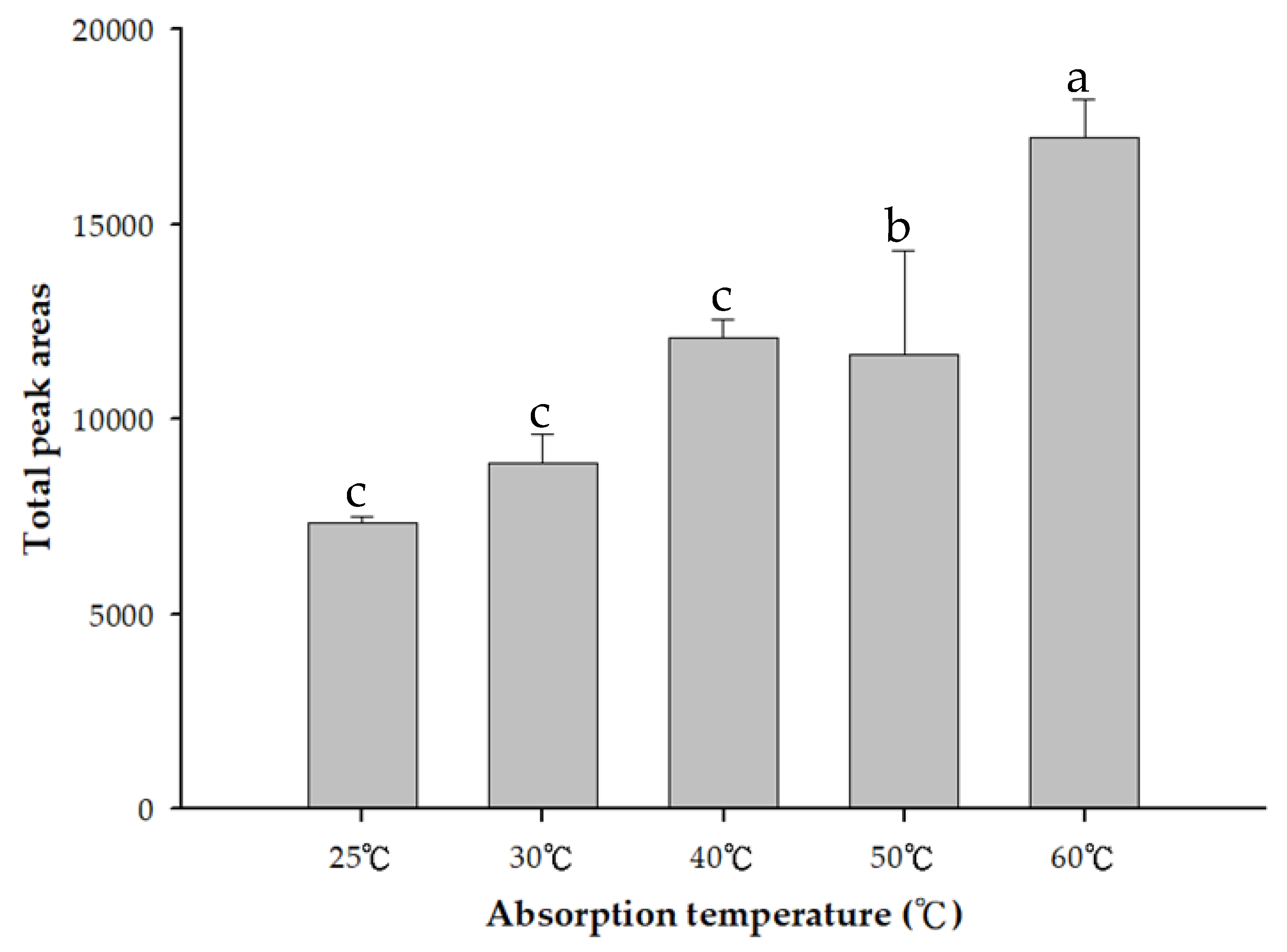
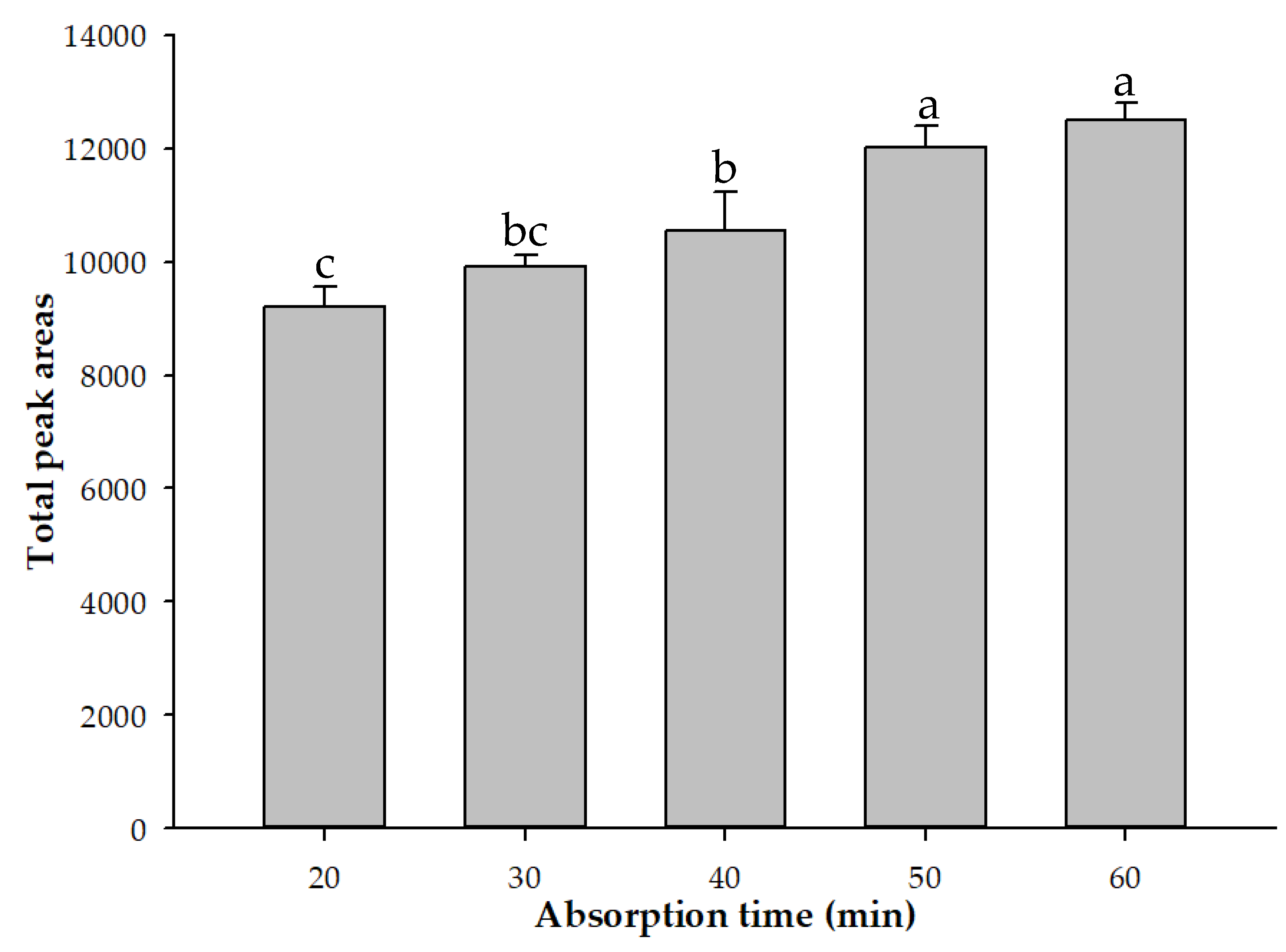
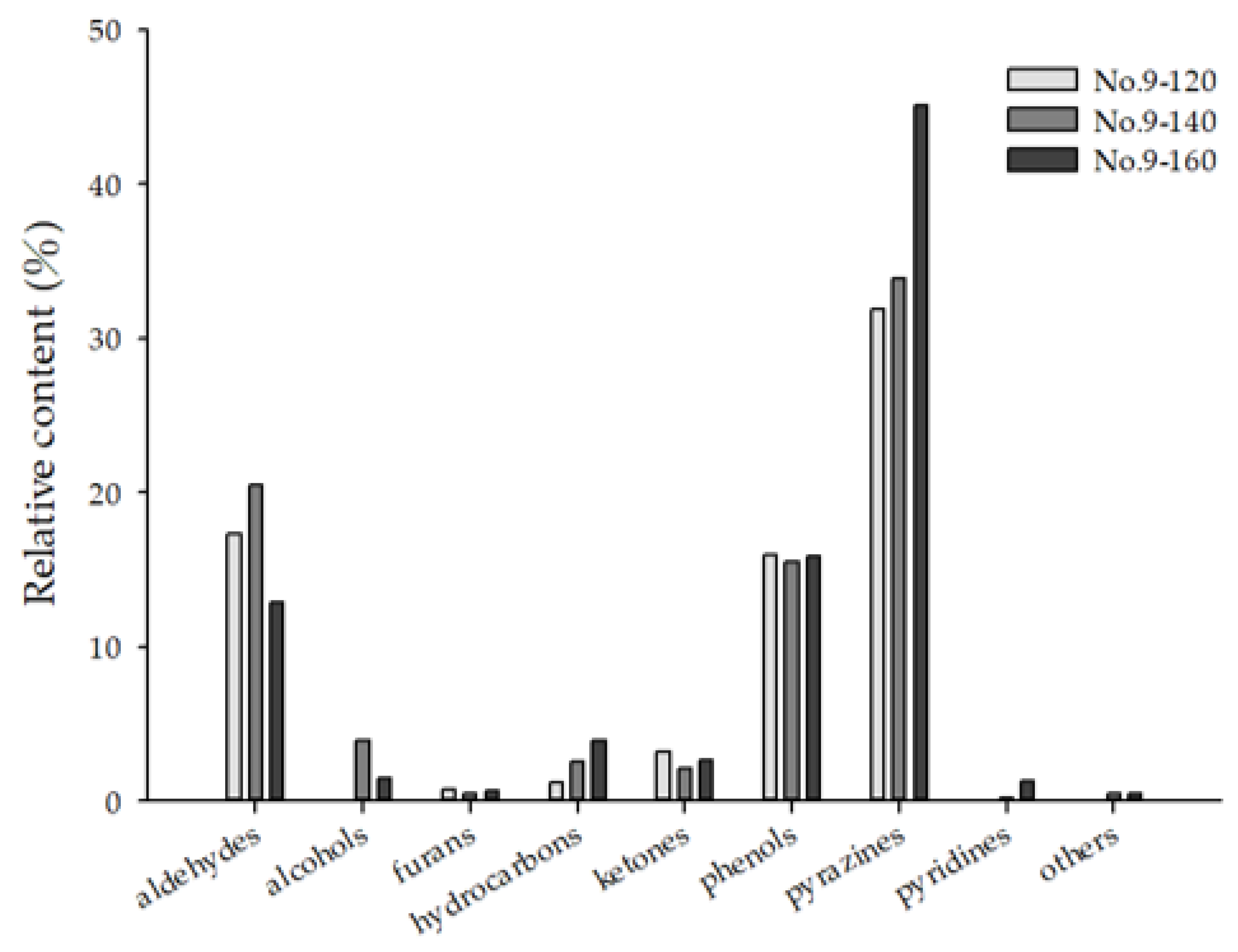

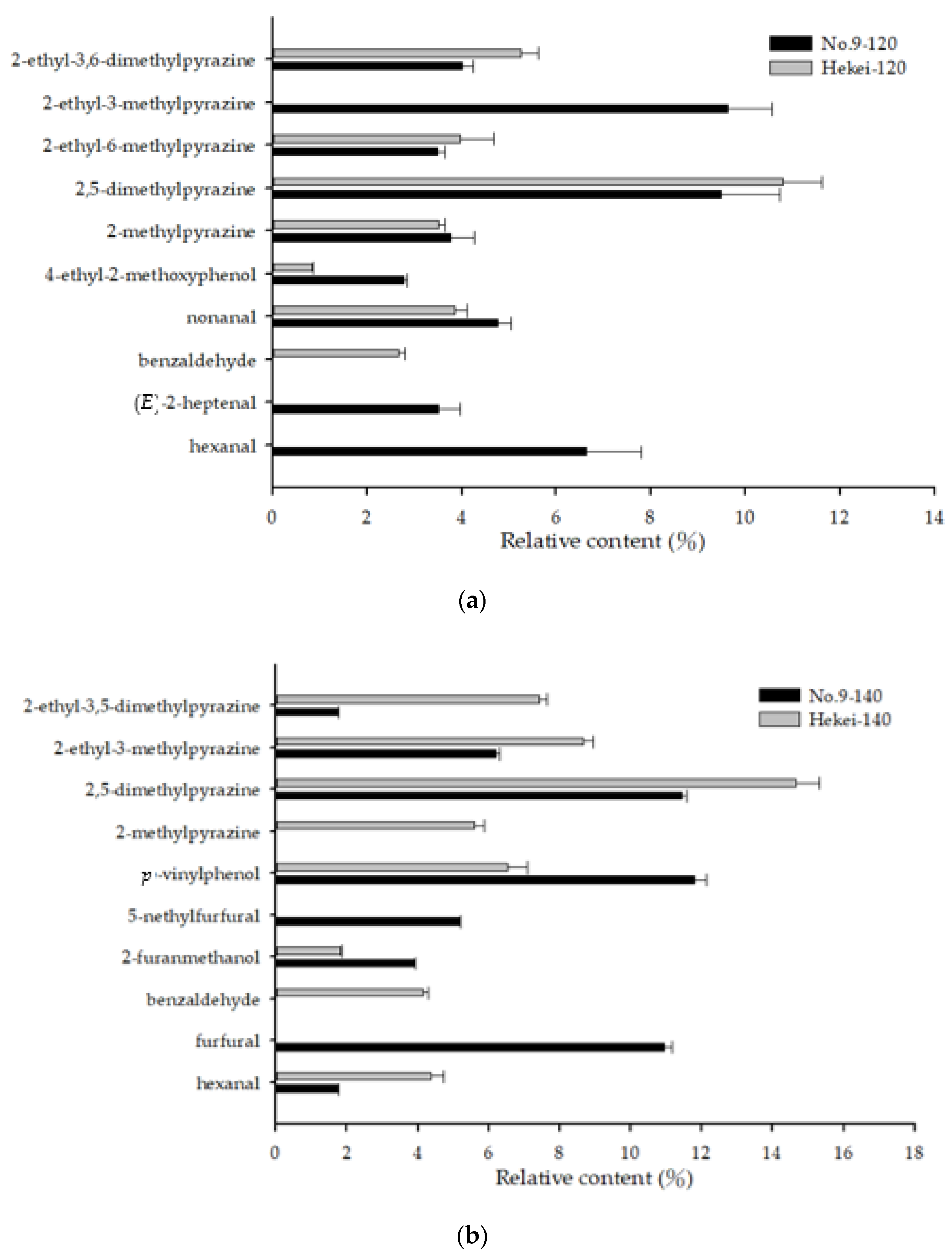


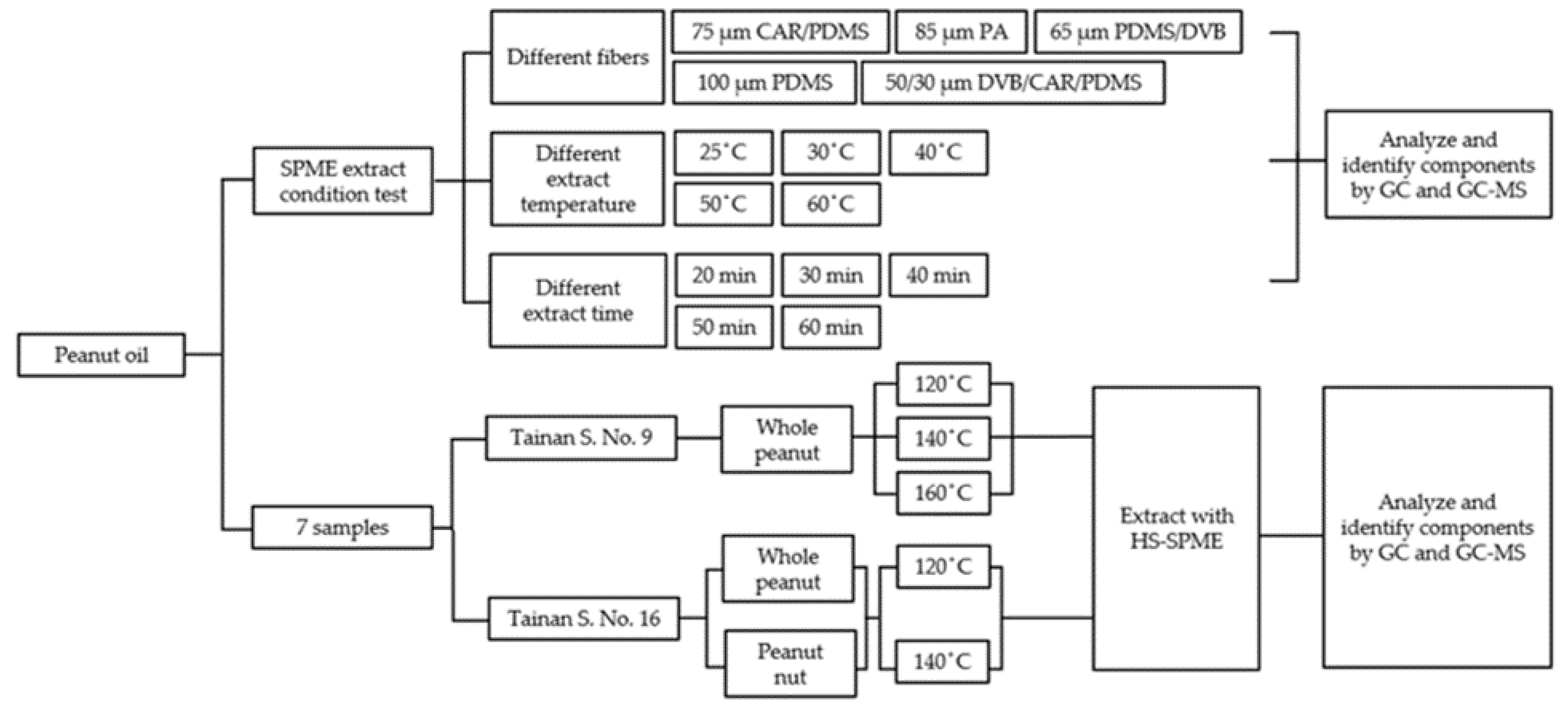
| Compound a | RI b | Relative Content (%) c | ||||||
|---|---|---|---|---|---|---|---|---|
| No.9-120 d | No.9-140 d | No.9-160 d | Hekei-120 d | Hekei-140 d | Heren-120 d | Heren-140 d | ||
| Aldehydes | ||||||||
| Hexanal | 775 | 6.64 ± 1.17 | 1.74 ± 0.04 | 2.21 ± 0.28 | 3.33 ± 0.15 | 4.38 ± 0.35 | 2.36 ± 0.21 | 2.01 ± 0.23 |
| Furfural | 798 | 10.94 ± 0.23 | ||||||
| (E)-2-Heptenal | 924 | 3.52 ± 0.45 | 2.01 ± 0.15 | 1.89 ± 0.02 | ||||
| Benzaldehyde | 927 | 2.67 ± 0.14 | 4.14 ± 0.15 | 1.82 ± 0.18 | ||||
| Benzeneacetaldehyde | 999 | 0.50 ± 0.02 | ||||||
| 1-Ethyl-1H-pyrrole-2-carboxaldehyde | 1009 | 0.31 ± 0.03 | ||||||
| 2-Octenal | 1023 | 1.27 ± 0.08 | 0.51 ± 0.01 | 0.74 ± 0.04 | 0.90 ± 0.02 | 1.05 ± 0.01 | 0.63 ± 0.01 | |
| Nonanal | 1073 | 4.77 ± 0.27 | 3.61 ± 0.13 | 3.85 ± 0.26 | 2.60 ± 0.07 | 3.88 ± 0.29 | ||
| (E)-2-Nonenal | 1127 | 2.09 ± 0.05 | ||||||
| 4-Oxononanal | 1198 | 0.26 ± 0.02 | 0.29 ± 0.06 | 0.22 ± 0.11 | ||||
| (E)-2-Decenal | 1235 | 0.43 ± 0.01 | ||||||
| A-Ethylidenbenzeneacetaldehyde | 1237 | 0.79 ± 0.03 | 1.30 ± 0.18 | 0.80 ± 0.05 | 0.79 ± 0.05 | 0.75 ± 0.04 | ||
| (2E,4Z)-Decadienal | 1265 | 0.40 ± 0.07 | 0.27 ± 0.00 | 0.27 ± 0.02 | ||||
| (2E,4E)-Decadienal | 1285 | 0.25 ± 0.01 | 0.36 ± 0.01 | 0.52 ± 0.38 | 0.60 ± 0.03 | 0.37 ± 0.01 | 0.39 ± 0.01 | 0.50 ± 0.02 |
| Vanillin | 1351 | 0.17 ± 0.04 | 0.14 ± 0.00 | 0.14 ± 0.03 | ||||
| Alcohols | ||||||||
| 2-Furanmethanol | 827 | 3.92 ± 0.02 | 1.49 ± 0.15 | 1.81 ± 0.05 | ||||
| 1-Octanol | 1042 | 0.47 ± 0.06 | ||||||
| Benzene ethanol | 1076 | 0.53 ± 0.05 | ||||||
| Furans | ||||||||
| Acetylfuran | 876 | 0.80 ± 0.13 | 0.50 ± 0.01 | 0.69 ± 0.04 | 0.84 ± 0.04 | 0.59 ± 0.02 | 0.46 ± 0.03 | 0.62 ± 0.14 |
| 2-Methyl-5-Formylfuran | 926 | 5.17 ± 0.03 | ||||||
| Hydrocarbons | ||||||||
| Ethenylbenzene | 870 | 0.48 ± 0.07 | ||||||
| Undecane | 1100 | 0.74 ± 0.02 | 1.16 ± 0.05 | 1.32 ± 0.11 | 1.01 ± 0.04 | 1.01 ± 0.04 | 1.07 ± 0.05 | |
| Naphthalene | 1162 | 0.27 ± 0.01 | 0.44 ± 0.14 | |||||
| Dodecane | 1200 | 0.78 ± 0.02 | 1.27 ± 0.02 | 1.48 ± 0.12 | 1.02 ± 0.01 | 1.16 ± 0.05 | 1.14 ± 0.03 | |
| Tridecane | 1300 | 0.55 ± 0.03 | 0.95 ± 0.15 | 1.03 ± 0.09 | 0.72 ± 0.06 | 0.77 ± 0.05 | ||
| 3-Phenylthiophene | 1384 | 0.18 ± 0.01 | ||||||
| Tetradecane | 1400 | 0.06 ± 0.01 | 0.41 ± 0.03 | 0.23 ± 0.06 | 0.25 ± 0.05 | 0.31 ± 0.08 | ||
| Butylated hydroxytoluene | 1488 | 0.74 ± 0.17 | 0.34 ± 0.11 | 0.45 ± 0.17 | 1.12 ± 0.05 | 0.50 ± 0.08 | 0.86 ± 0.18 | |
| Ketones | ||||||||
| Methyl pyrrol-2-yl ketone | 1015 | 2.32 ± 1.62 | 1.46 ± 0.10 | 1.90 ± 0.05 | 1.26 ± 0.02 | 1.45 ± 0.07 | 1.65 ± 0.08 | 1.48 ± 0.11 |
| Acetophenone | 1027 | 0.61 ± 0.09 | 0.64 ± 0.01 | 0.74 ± 0.01 | 0.59 ± 0.11 | 0.68 ± 0.01 | 0.37 ± 0.01 | |
| γ-Nonalactone | 1313 | 0.25 ± 0.01 | 0.15 ± 0.00 | |||||
| Phenols | ||||||||
| Phenol | 949 | 0.48 ± 0.01 | ||||||
| p-Cresol | 1041 | 0.31 ± 0.05 | ||||||
| p-Ethylphenol | 1133 | 12.85 ± 0.60 | 0.39 ± 0.01 | 2.30 ± 0.25 | 7.21 ± 0.14 | 0.26 ± 0.01 | 1.67 ± 0.12 | 11.36 ± 0.44 |
| p-Vinylphenol | 1183 | 11.80 ± 0.32 | 10.00 ± 1.32 | 2.54 ± 0.05 | 6.53 ± 0.56 | 6.73 ± 0.46 | 2.81 ± 0.22 | |
| 4-Ethyl-2-methoxyphenol | 1252 | 2.78 ± 0.07 | 0.84 ± 0.03 | 0.33 ± 0.01 | ||||
| Sesamol | 1278 | 0.23 ± 0.13 | ||||||
| 2-Methoxy-4-vinylphenol | 1281 | 0.30 ± 0.02 | 2.82 ± 0.07 | 2.67 ± 0.33 | 1.30 ± 0.05 | 1.59 ± 0.06 | 1.63 ± 0.14 | 1.32 ± 0.07 |
| p-(1-Methylpropyl)phenol | 1287 | 0.39 ± 0.06 | 0.36 ± 0.02 | 0.14 ± 0.01 | ||||
| Pyrazines | ||||||||
| Pyrazine | 725 | 1.47 ± 0.16 | ||||||
| 2-Methylpyrazine | 796 | 3.78 ± 0.48 | 5.19 ± 0.33 | 3.52 ± 0.12 | 5.60 ± 0.26 | 5.68 ± 0.27 | 3.69 ± 0.19 | |
| 2,5-Dimethylpyrazine | 881 | 9.48 ± 1.26 | 11.43 ± 0.15 | 12.98 ± 1.34 | 10.80 ± 0.82 | 14.65 ± 0.67 | 20.14 ± 0.58 | 13.54 ± 1.57 |
| Vinylpyrazine | 897 | 0.16 ± 0.00 | ||||||
| 2-Ethyl-6-methylpyrazine | 966 | 3.49 ± 0.15 | 4.96 ± 0.06 | 3.42 ± 0.23 | 3.96 ± 0.72 | 3.81 ± 0.17 | 2.86 ± 0.04 | 3.46 ± 0.05 |
| 2-Ethyl-3-methylpyrazine | 970 | 9.63 ± 0.92 | 6.20 ± 0.10 | 8.25 ± 1.04 | 8.66 ± 0.29 | 11.60 ± 0.29 | 10.96 ± 0.80 | |
| 2-Methyl-6-vinylpyrazine | 981 | 2.51 ± 0.01 | 0.85 ± 0.06 | 2.56 ± 0.07 | 0.81 ± 0.01 | 1.12 ± 1.18 | ||
| 2-Methyl-5-vinylpyrazine | 985 | 2.14 ± 0.02 | 4.34 ± 2.18 | |||||
| 2-Ethyl-3,6-dimethylpyrazine | 1048 | 4.01 ± 0.23 | 3.54 ± 0.02 | 5.26 ± 0.36 | 4.43 ± 0.47 | |||
| 2-Ethyl-3,5-dimethylpyrazine | 1054 | 1.75 ± 0.03 | 7.35 ± 0.60 | 7.41 ± 0.23 | 6.75 ± 0.19 | 1.69 ± 0.13 | ||
| 5-Ethyl-2,3-dimethylpyrazine | 1055 | 2.04 ± 0.06 | ||||||
| 2,5-Diethylpyrazine | 1058 | 0.32 ± 0.01 | 0.31 ± 0.00 | 0.39 ± 0.01 | 0.35 ± 0.01 | 0.39 ± 0.01 | 0.42 ± 0.01 | 0.37 ± 0.02 |
| 6,7-Dihydro-5H-cyclopentapyrazine | 1066 | 1.24 ± 0.01 | ||||||
| Dimethyl-2-vinylpyrazine | 1067 | 1.18 ± 0.03 | 1.47 ± 0.06 | 1.37 ± 0.01 | ||||
| 6-Methyl-2-acetylpyrazine | 1080 | 1.02 ± 0.04 | 0.91 ± 0.05 | 0.33 ± 0.00 | 0.79 ± 0.04 | 0.49 ± 0.11 | 0.43 ± 0.02 | |
| 5H-5-Methyl-6,7-dihydrocyclopentapyrazine | 1102 | 0.56 ± 0.00 | 0.44 ± 0.01 | 0.73 ± 0.01 | 0.53 ± 0.01 | 0.55 ± 0.04 | ||
| 2-Methyl-3,5-diethylpyrazine | 1128 | 1.69 ± 0.08 | 1.51 ± 0.07 | |||||
| 3,5-Dimethyl-2-isobutylpyrazine | 1176 | 0.20 ± 0.01 | ||||||
| 2,5-Dimethyl-3-isobutylpyrazine | 1178 | 0.20 ± 0.02 | 0.39 ± 0.01 | |||||
| 3,5-Dimethyl-6,7-dihydro-5H-cyclopentapyrazine | 1189 | 0.37 ± 0.01 | ||||||
| 2,5-Dimethyl-3-isopentylpyrazine | 1295 | 0.15 ± 0.01 | ||||||
| Pyridines | ||||||||
| β-Methoxypyridin | 961 | 0.21 ± 0.01 | 0.73 ± 0.12 | 0.92 ± 0.02 | ||||
| 2-Methyl 5H-6,7-dihydrocyclopentapyrazine | 1158 | 0.70 ± 0.04 | 0.48 ± 0.03 | 0.67 ± 0.00 | 0.20 ± 0.17 | |||
| 2-Propylpyridine | 1171 | 0.54 ± 0.07 | 0.27 ± 0.01 | |||||
| Others | ||||||||
| Benzeneacetonitrile | 1085 | 0.36 ± 0.00 | 0.43 ± 0.01 | 0.33 ± 0.03 | ||||
| Trigonelline | 1096 | 0.32 ± 0.02 | ||||||
| Methyl nicotinate | 1095 | 0.46 ± 0.01 | 0.45 ± 0.04 | 0.28 ± 0.02 | 0.31 ± 0.04 | |||
| Sample Name | Variety | Pressure Oil Part | Roasting Temperature (°C) |
|---|---|---|---|
| No.9-120 | Tainan Selected No. 9 | Shell and nut | 120 |
| No.9-140 | Tainan Selected No. 9 | Shell and nut | 140 |
| No.9-160 | Tainan Selected No. 9 | Shell and nut | 160 |
| Hekei-120 | Tainan Selected No. 16 (Hei King Kong) | Shell and nut | 120 |
| Hekei-140 | Tainan Selected No. 16 (Hei King Kong) | Shell and nut | 140 |
| Heren-120 | Tainan Selected No. 16 (Hei King Kong) | nut | 120 |
| Heren-140 | Tainan Selected No. 16 (Hei King Kong) | nut | 140 |
Publisher’s Note: MDPI stays neutral with regard to jurisdictional claims in published maps and institutional affiliations. |
© 2021 by the authors. Licensee MDPI, Basel, Switzerland. This article is an open access article distributed under the terms and conditions of the Creative Commons Attribution (CC BY) license (https://creativecommons.org/licenses/by/4.0/).
Share and Cite
Yang, K.-M.; Chao, L.K.; Wu, C.-S.; Ye, Z.-S.; Chen, H.-C. Headspace Solid-Phase Microextraction Analysis of Volatile Components in Peanut Oil. Molecules 2021, 26, 3306. https://doi.org/10.3390/molecules26113306
Yang K-M, Chao LK, Wu C-S, Ye Z-S, Chen H-C. Headspace Solid-Phase Microextraction Analysis of Volatile Components in Peanut Oil. Molecules. 2021; 26(11):3306. https://doi.org/10.3390/molecules26113306
Chicago/Turabian StyleYang, Kai-Min, Louis Kuoping Chao, Chin-Sheng Wu, Zih-Sian Ye, and Hsin-Chun Chen. 2021. "Headspace Solid-Phase Microextraction Analysis of Volatile Components in Peanut Oil" Molecules 26, no. 11: 3306. https://doi.org/10.3390/molecules26113306
APA StyleYang, K.-M., Chao, L. K., Wu, C.-S., Ye, Z.-S., & Chen, H.-C. (2021). Headspace Solid-Phase Microextraction Analysis of Volatile Components in Peanut Oil. Molecules, 26(11), 3306. https://doi.org/10.3390/molecules26113306







